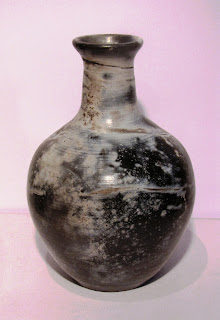It was a cold and breezy Saturday night when I did the first firing in my newly built 'Raku Kiln' (posted details in my last blog). I was anxious to start the kiln to see how it would fire and to see the finished pots. The whole process of raku firing is dangerous, exciting, fast and almost ritualistic. There is that connection and excitement firstly as I have been a part of the whole process of making the pots. With raku firing though, I am able to see the transformation inside the kiln as they change from cold to glowing red hot. Then taking the red hot pots (1000 deg c) from the kiln and placing them into the reduction bins to ignite into flames. At the end of this process, cleaning off the carbon to reveal the hidden treasures is like a type of metamorphosis. Sometimes exhilerating and at times disappointing. The joy of Raku.
There is an explanation of 'Raku Firing' in my last post.
There is an explanation of 'Raku Firing' in my last post.
 |
| All ready to go |
 |
| Glazed pots in the kiln |
I had set everything up earlier in the day so that we were ready to fire that night. I personally like to raku fire at night as it is much easier to see the temperature of the kiln by the colour inside and the shine of the glaze on the pots, which tells me they are ready to be removed. Five large metal tins and eight smaller ones, gloves, tongs, garden hose and a bucket of water nearby. I used newspaper as my reduction material inside the tins and all tins had lids. As the kiln was set up and packed earlier in the day, all there was to do was turn on the kiln and away we went. My three willing helpers, two daughter's Sarah and Alison and my husband Glen, volunteered to brave the cold night to participate and I could not have done it without their help. I packed the kiln using three small kiln shelves which were elevated on props so that the burner flame could pass underneath, hit a broken kiln shelf at the other end, then directed the flame up and over the arch.
View of the burner path and pots through the chimney early in the firing
I started the kiln at about 6.40pm and turned off the burner at 8.10pm, so an hour and a half from start to finish. I could have probably left it on for a little longer, but my impatience got the better of me. I was generally very pleased with how the kiln fired and my only observation was that it fired a little cooler at the end where the burner was which can be tweaked by adjusting a few things.
The glazes I used on the pots for this fiing were; white crackle, turquoise and copper matt. Results were varied, depending on how much reduction I got in the bins, but overall I am quite happy with the results and I have learned a little bit more for the next time around. The no fail white crackle I really like. I particularly love the turquoise glaze which crazed beautifully on the inside of the trinket boxes and I even got some lovely copper red flashing too, so that was a nice extra surprise. Can't wait to do my next raku firing...
Note: To see a larger image of the photos on this page, hover over the image and click with your mouse.
Note: To see a larger image of the photos on this page, hover over the image and click with your mouse.
Pots straight out of reduction bins on left and after cleaning on right
























